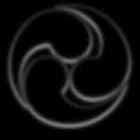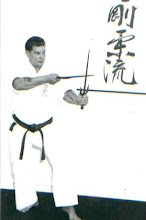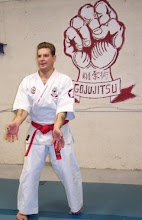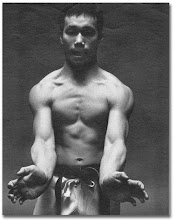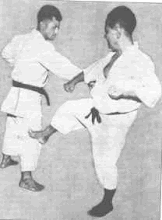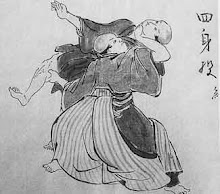A review of reviews, and
personal findings, by Steven L. Malanoski
personal findings, by Steven L. Malanoski
Much has been said, written and therefore believed and passed on, about this most famous book. There have been constant praises since it’s writing, and in the past few years, quite a bit of critique.
The purpose of this article, is to clarify, and hopefully put to rest, some of the critique, questions, innuendoes, confusions, and misunderstandings that have arose since its first being written by my teacher, Peter G. Urban, in 1962 through 64 when it was privately published by Urban who was thirty years old, and later in 1967, published by the Charles E. Tuttle Company of Rutland Vermont, and Tokyo Japan.
This book has been a required reading for not just GoJu,but many, many styles, and is easily as popular as Funakoshi’s KaraTe Do My Way Of Life. The only book similar, that was published in English, before The KaraTe DoJo, was Jay Gluck’s Zen Combat, in which, incidentally, there is a sketch of Urban that was taken from a picture in Oyama’s What is KaraTe?
In an article published in Black Belt Magazine’s March 1969 issue, The Budo Books review by Phillip J. Rasch was a bit less than complimentary. Although this article had absolutely no effect on it’s becoming a best seller and a book that continues to this day to be a revered MUST READ, it
was a bit of a slap in the face considering that in the same magazine, there is also an article about Grand Master Urban.
was a bit of a slap in the face considering that in the same magazine, there is also an article about Grand Master Urban.
The book review read, and I quote:
Budo Books, by Phillip Rasch “ The contents of this little book are better described by its subtitle, Traditions and tales of a martial art, than by its title. About half of the text is devoted to a general description of karate; the second half is free association relating to the martial arts, much of it in the form of folk tales, recollections of personalities, observations on the current scene, etc.
The author eschews all mystic explanations of Ki describing it as the ability to focus “all physical, mental, and spiritual energies of a human being … upon a particular point with all the concentration of which a person is capable.” This seems scientifically acceptable. Under the stress of strong emotion a human being may perform feats normally beyond his capacity. It appears entirely possible that proper methods of training might bring about these same capabilities under voluntary control.
It is not possible to be equally happy with the contention (pp. 45 – 46) that in the martial arts, the student’s advancement from one level to the next depends as much on the development of his character as upon his skill. Urban himself goes on to say (p. 142) that many masters of the martial
arts engage in “petty jealousies and squabbles.” In essence, this the same question that the Japanese failed to answer when confronted with questions about the treatment of prisoners in WW2 often received from high ranking JuDoKa who had similarly advance a path of alleged spiritual development. The reviewer has had a good deal of psychiatric training and has been particularly interested in the validity of such claims. He has observed no particular personality change in his friends as they advanced in one or another of the martial arts. Perhaps more to the point, a recent study by Kroll and Carlson has shown that the Cattell sixteen personality factor questionnaire reveals no significant profile differences between novice, intermediate, and advanced karateka. Neither are there differences between karateka and non karateka.
arts engage in “petty jealousies and squabbles.” In essence, this the same question that the Japanese failed to answer when confronted with questions about the treatment of prisoners in WW2 often received from high ranking JuDoKa who had similarly advance a path of alleged spiritual development. The reviewer has had a good deal of psychiatric training and has been particularly interested in the validity of such claims. He has observed no particular personality change in his friends as they advanced in one or another of the martial arts. Perhaps more to the point, a recent study by Kroll and Carlson has shown that the Cattell sixteen personality factor questionnaire reveals no significant profile differences between novice, intermediate, and advanced karateka. Neither are there differences between karateka and non karateka.
Occasionally the book contains references that will cause the psychologist to wince! An example is the description of the kiai as a scream “propelled by the muscles of the lower diaphragm.” The diaphragm is a domed musculo – tendanus sheet. Just what constitutes the “muscles of the lower
diaphragm” or how one contracts any given part of this muscle without contraction of the rest is not apparent. In this connection one would expect a reference to the work of Ikai and Steinhaus, but it is not mentioned.
diaphragm” or how one contracts any given part of this muscle without contraction of the rest is not apparent. In this connection one would expect a reference to the work of Ikai and Steinhaus, but it is not mentioned.
The little stories which make up most of the second part of the text are pleasant reading. Relevant to the sensei who ran up and down the ladder of sword blades, years ago the reviewer heard from a circus performer who featured this same feat that it was not particularly difficult one was careful to maintain an absolute lack of horizontal movement when placing the feet. The account of the unnamed karate master killing a tiger with his bare hands may seem unbelievable, but Sir Edward Winter is supposed to have actually done this while in command of Fort Saint George in Madras, India.
The book will be particularly enjoyed by those who have only heard of karate, know nothing of it, and would like to learn something of its background rather than its technique.”
End quote
In an article published in the Vol. 5 no. 2 issue of the British magazine, Fighting Arts, that was written by Graham Noble, the topic of the story about Gogen Yamaguchi fighting a tiger is discussed. Mention is made, as to how Yamaguchi had denied having fought a tiger, as per Urban’s story in The KaraTe DoJo, when asked about it by James Genovese.
Malanoski’s notes:
1. I had also heard elsewhere, that Yamaguchi’s reply when asked about the tiger was, “Peter was exaggerating.”, however, also mentioned in the Fighting Arts magazine article, is the fact that in his interview with Ronlad Gailec in the French magazine KaraTe in the April 1977 issue, Yamaguchi is quoted as saying, “In Manchuria one day I went away into the mountains and had a fight with a
tiger, with bare hands. It was a terrible experience… I repeated this experience later, before witnesses. “(J’ai reneouvele cette experience par la suite, devant temoins).”
1. I had also heard elsewhere, that Yamaguchi’s reply when asked about the tiger was, “Peter was exaggerating.”, however, also mentioned in the Fighting Arts magazine article, is the fact that in his interview with Ronlad Gailec in the French magazine KaraTe in the April 1977 issue, Yamaguchi is quoted as saying, “In Manchuria one day I went away into the mountains and had a fight with a
tiger, with bare hands. It was a terrible experience… I repeated this experience later, before witnesses. “(J’ai reneouvele cette experience par la suite, devant temoins).”
2. When I asked Grand Master Urban about this, he told me that Yamaguchi had personally told him the tiger story. There has been mention on the internet that The KaraTe DoJo has caused many to have erroneous beliefs about Choki Motobu, i.e.: his being 11 ft. tall etc. The fact of the matter is that the Okinawan Champion story was not actually supposed to be Choki Motobu, but a fictional character Choku Matobu. Yes, there is a definite influence, ie: his being aced out of teaching fame by Gichin Funakoshi, but let me make a couple of points clear.
It is a fact, that many people peruse books, which is to say, they flip from page to page at random, rather than reading from cover to cover in proper order. Because of this, there are many of these “literary geniuses” that completely missed pages 81 and 82 which I will quote here:
Famous DoJo Stories “Researching thehistory of the martial arts is in the final analysis a matter of accumulating the best of the living oriental scholars and the great practitioners. It cannot realistically
Famous DoJo Stories “Researching thehistory of the martial arts is in the final analysis a matter of accumulating the best of the living oriental scholars and the great practitioners. It cannot realistically
be determined when any of these arts began or by whom. It is generally accepted by KaraTe devotees that Bodhidharma started the original martial arts concept with the propagation of his Zen sect into China and, through Zen Buddhism, into Japan. But no one can state unequivocally that this is a fact, for, although ancient Chinese and Japanese documents regarding the martial arts do exist, they contradict each other. The general practice of martial arts scholars is to accept the most authentic the opinions of the most erudite and intellectually superior individuals only because their guesses are more educated; however, all scholars, no matter how erudite, preface their findings with an apology for their lack of responsibility for historical accuracy. The following collection of stories represents the history of karate as I envision it, having gleaned what seems to me to be the most feasible from the massive amounts of contradictory material written on the subject. I have found from my brief experience of only fifteen and a half years of formal practice and research that nothing is impossible in the martial arts, and therefore take the liberty to depict the past as I believe it was or mite well have been. I do not choose to argue with the greater Oriental scholars in the event of disputes with my opinions, but will bow to them on the premise that my guesses are based on less experience than theirs. However I believe my findings to be more profound than all the tales and myths about Karate that have been handed down to martial arts devotees for generations. I am basing my conclusions on the admixture of intimate experience, creative imagination, free observation, personal reason, and logic. I have written this book in accordance with the view that sometimes it is better to tell the truth in the guise of stories so as to offend the fewest people, and entertain the most readers. Also, I hope to inform the few who do not need academic accreditation and the dictates of others to help them decide what is true, what is not true, what is good, what is bad.” End Quote
In Urban’s last work, published after his death, KaraTe Stories and Values, he explains that the Matobu in the story and Choki Motobu are not the same people. This point is also covered in DoJo 2, the talking book CDs which are available at www.urbangojuusa.com
On a more jovial note, someone from Hollywood obviously skipped the affore mentioned pages, or perhaps downright plagiarized my teacher when they wrote the script for the original TV series Kung Fu. Those of you, who are old enough to remember this show, will remember the scene from the first episode in which Kwai Chang Kain picks up the red hot urn with his forearms, thus burning the dragon and tiger seal of shaolin on his inner forearms.
On a more jovial note, someone from Hollywood obviously skipped the affore mentioned pages, or perhaps downright plagiarized my teacher when they wrote the script for the original TV series Kung Fu. Those of you, who are old enough to remember this show, will remember the scene from the first episode in which Kwai Chang Kain picks up the red hot urn with his forearms, thus burning the dragon and tiger seal of shaolin on his inner forearms.
Well guess what? If you look on page 83 of The KaraTe DoJo, you will find the story from which the Kung Fu red hot urn scene came from. Incidentally, Grand Master Urban told me himself, that he made that story up, as he laughed about how it was stolen by Hollywood and his
never given any stipend, much less any credit.
It goes without saying, that the purpose of this article is not to disrespect my teacher, but to give the reader a clear and concise understanding of what it is that the book contains, and what can and cannot be gleaned from it.
Less there be misunderstanding.
And as my teacher would say; MISUNDERSTANDINGS
KILL………………………………..
KILL………………………………..










